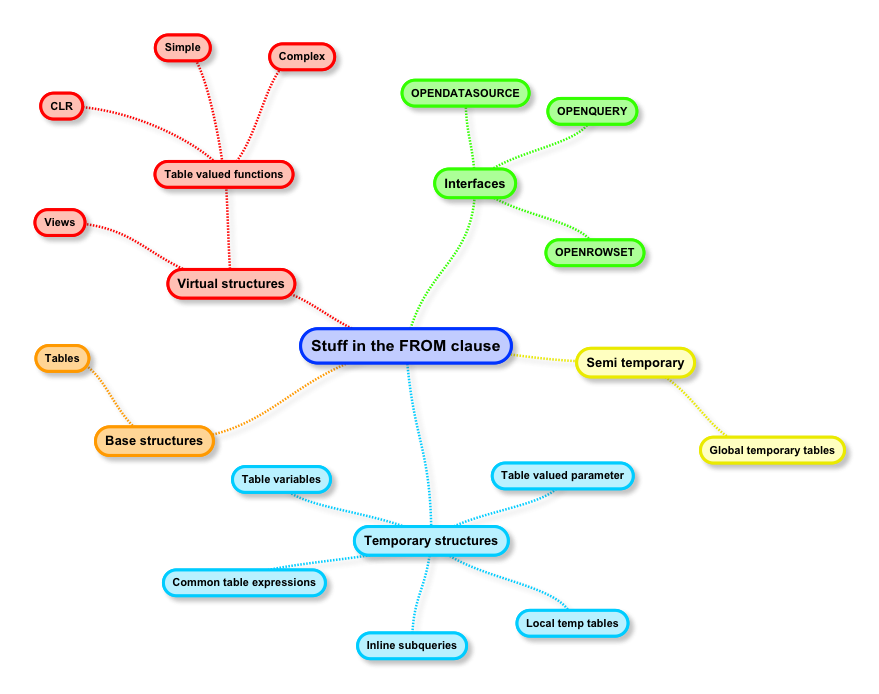Continuing with my SQL Server basics series, I’m focusing this post on Stuff in the FROM clause: Virtual Structures. My last post talked about the only Base structure in a relational database, but I’m now moving on to a slightly more complicated concept. Virtual structures are database objects that don’t hold data in a tabular structure, but can interface with data in a tabular format. It’s probably best to start with the most common virtual structure, the VIEW:
VIEWs
According to Books Online, VIEWs create "a virtual table whose contents (columns and rows) are defined by a query. Use this statement to create a view of the data in one or more tables in the database.” A view encapsulates a SQL SELECT statement to return data, and can be used to provide an alternate representation of data from the original tables. For example, the following VIEW returns columns from both the Person and Employees tables in the AdventureWorks sample database:
USE AdventureWorks2008R2 ;
GO
IF OBJECT_ID ('hiredate_view', 'V') IS NOT NULL
DROP VIEW hiredate_view ;
GO
CREATE VIEW hiredate_view
AS
SELECT p.FirstName, p.LastName, e.BusinessEntityID, e.HireDate
FROM HumanResources.Employee e
JOIN Person.Person AS p ON e.BusinessEntityID = p.BusinessEntityID ;
GO
Views are not just read-only; in certain cases, VIEWS can be used to insert or update data into underlying tables. However, discussion of how this works is beyond the intent of this introduction; refer to Books Online fore more information.
Table-Valued Functions (TVF)
Views are not the only virtual structures available in SQL Server; a subset of a user-defined function known as table-valued functions (TVFs) also provide interfaces into the underlying base structures. Books Online defines table-valued functions as “a Transact-SQL or common language runtime (CLR) routine that accepts parameters, performs an action, such as a complex calculation, and returns the result of that action as… a table.” There are three types of TVF’s (arranged below in order of increasing complexity): simple, complex, and Common Language Runtime.
Simple TVFs
A simple (or inline) table-valued function is probably the easiest virtual structure to grasp beyond a view; in fact, it’s easily compared to a view with parameters. A simple TVF encapsulates a SQL statement (much like a view), but it allows for the use of parameters to filter the results returned. For example, the following simple TVF pulls data from multiple tables for a specific StoreID:
USE AdventureWorks2008R2;
GO
IF OBJECT_ID (N'Sales.ufn_SalesByStore', N'IF') IS NOT NULL
DROP FUNCTION Sales.ufn_SalesByStore;
GO
CREATE FUNCTION Sales.ufn_SalesByStore (@storeid INT)
RETURNS TABLE
AS
RETURN
(
SELECT P.ProductID, P.Name, SUM(SD.LineTotal) AS 'Total'
FROM Production.Product AS P
JOIN Sales.SalesOrderDetail AS SD ON SD.ProductID = P.ProductID
JOIN Sales.SalesOrderHeader AS SH ON SH.SalesOrderID = SD.SalesOrderID
JOIN Sales.Customer AS C ON SH.CustomerID = C.CustomerID
WHERE C.StoreID = @storeid
GROUP BY P.ProductID, P.Name
);
GO
--use the new TVF in a query
SELECT * FROM Sales.ufn_SalesByStore (602);
Complex TVFs
Complex (or multi-statement) TVF’s are much like their simple counterparts, but allow for greater flexibility in T-SQL coding by adopting a procedural approach to returning tabular data. A complex TVF requires that a table variable (to be covered later) be defined within the function, and then populated by a series of SQL statements. The below example from Books Online shows how:
USE AdventureWorks2008R2;
GO
IF OBJECT_ID (N'dbo.ufn_FindReports', N'TF') IS NOT NULL
DROP FUNCTION dbo.ufn_FindReports;
GO
CREATE FUNCTION dbo.ufn_FindReports (@InEmpID INTEGER)
RETURNS @retFindReports TABLE
(
EmployeeID INT PRIMARY KEY NOT NULL,
FirstName NVARCHAR(255) NOT NULL,
LastName NVARCHAR(255) NOT NULL,
JobTitle NVARCHAR(50) NOT NULL,
RecursionLevel INT NOT NULL
)
--Returns a result set that lists all the employees who report to the
--specific employee directly or indirectly.*/
AS
BEGIN
WITH EMP_cte(EmployeeID, OrganizationNode, FirstName, LastName, JobTitle, RecursionLevel) -- CTE name and columns
AS (
SELECT e.BusinessEntityID, e.OrganizationNode, p.FirstName, p.LastName, e.JobTitle, 0 -- Get the initial list of Employees for Manager n
FROM HumanResources.Employee e
INNER JOIN Person.Person p
ON p.BusinessEntityID = e.BusinessEntityID
WHERE e.BusinessEntityID = @InEmpID
UNION ALL
SELECT e.BusinessEntityID, e.OrganizationNode, p.FirstName, p.LastName, e.JobTitle, RecursionLevel + 1 -- Join recursive member to anchor
FROM HumanResources.Employee e
INNER JOIN EMP_cte
ON e.OrganizationNode.GetAncestor(1) = EMP_cte.OrganizationNode
INNER JOIN Person.Person p
ON p.BusinessEntityID = e.BusinessEntityID
)
-- copy the required columns to the result of the function
INSERT @retFindReports
SELECT EmployeeID, FirstName, LastName, JobTitle, RecursionLevel
FROM EMP_cte
RETURN
END;
GO
-- Example invocation
SELECT EmployeeID, FirstName, LastName, JobTitle, RecursionLevel
FROM dbo.ufn_FindReports(1);
GO
Note that code in a multi-statement TVF can involve several steps before returning the final result-set; caution should be used when using complex TVF’s because the optimizer can not determine the cost of these statements during plan estimation. In short, the more complex the TVF, the more likely that the plan used by SQL Server will be inaccurate.
CLR TVF’s
With the release of SQL Server 2005, Microsoft embedded a limited subset of the functionality from the .NET framework into SQL Server itself, calling it the Common Language Runtime (CLR). The CLR allows for .NET developers to write and deploy database objects in a managed language (like VB.NET or C#), and allows for very flexible logic for handling data. A CLR Function is invoked in a fashion similar to other table-valued functions, but the deployment is much more involved (see Books Online for an example using the following steps):
- Code is written and assembled by a compiler (like Visual Studio).
- The assembled code must be copied on to the SQL Server.
- An ASSEMBLY reference is created in T-SQL, which points to the deployed .dll file, and
- a FUNCTION is created which references the ASSEMBLY.
Next up…
A two-fer: Temporary and Semi-Temporary structures!
